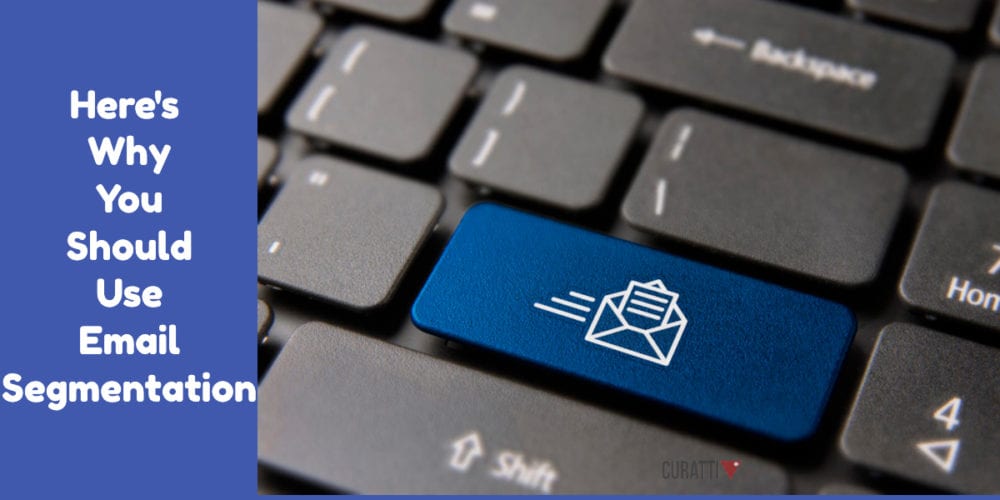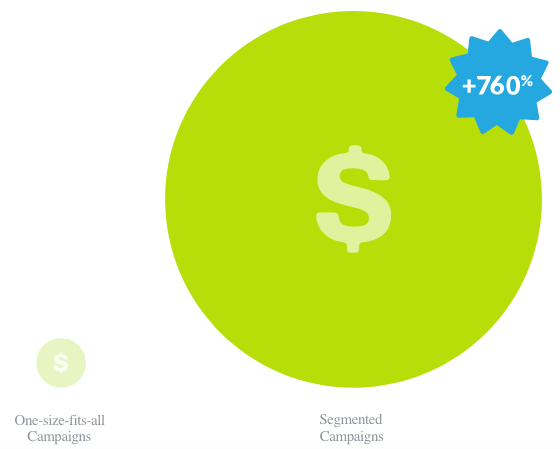Use Email Segmentation to Improve Your Marketing and Communication

Have your email marketing click-thru and open rates been on the decline lately? If you are not sending your messages to specific and targeted lists by use of email segmentation, you might be missing out on valuable prospects.
According to Campaign Monitor, e

Image courtesy Campaign Monitor
In order to attract leads, you need to specifically cater to a particular group of subscribers with remarkable content that they have already expressed interest in.
The Basics of Email Segmentation
It’s best to automate emails for specific lists from your website and from other marketing campaigns. Of course, these are not only more relevant to your subscribers. But they also save your business from wasting valuable time and help build better relationships. A personalized approach that includes valuable promotions can go a long way in encouraging someone to make a purchase.
In each phase of segmenting your lists, you are honing in on the specific pain points of your leads by focusing on the “why” of signing up in the first place. According to marketing expert, Neil Patel, the “batch and blast” approach yields very little results.
If you provide something of interest and assistance to your subscribers and customers with added value for them your emails will not be forgotten. This can happen in several different ways:
- New product and feature announcements to those who have not yet made a purchase
- A video or personalized look at how your business operates
- Tips and tricks the subscriber may have missed online from your brand
- A discount code for previous customers who have not bought anything for a while
- Friendly reminders on what subscribers might be missing
These are all great opportunities you can use to transform a visitor into a prospect and after gaining their trust in a targeted message that appeals specifically to their needs and desires.
You may also want to read: AI in Email Marketing: A Huge Step Towards Better Emails [Infographic]
How to Create a Segmented Email Campaign
If you use any of the major email services such as Aweber, MailChimp, ConvertKit, etc. then you may already have an autoresponder in place. In order to make this more effective, you will want to recreate this according to each list that you may have. If you are just starting at building up your list plan ahead of time to segment now in order to save more time later. Here are a few ways to make this more simple:
1 – Use a Keyword ‘Tag’ For The Type of List Generated
In your email client, you will want to create a ‘tag’ according to the links clicked on from your website or advertising campaigns. Some services may offer a click automation system, which segments your subscribers according to their interests. The goal is to send your messages to a very select group instead of all of your lists in order to generate more interest.
2 – Give Current Customers and Subscribers a Reason to Stay
Show your subscribers that your business is interested in learning more about their specific needs with targeted questions — in return for their answers offer them a free eBook chapter, report, tips, etc.
Incentives increase open rates with the reward of adding something of value that your audience can really use. Once they have tried what you have the offer they will be more likely to return for a full purchase.
3 – Hook The Reader With a Great Headline
Test out your subject lines before you create a campaign with a good headline analyzer. The more broad or common the title the more likely your message will be deleted and not even be read. The best types of headlines appeal to the reader’s emotions right away and provide them a reason to open your email. Here are a few creative uses to follow from Hubspot:
- Use conversational worlds like, “Uh-oh” that don’t sell directly
- Include humor
- On occasion use emojis to capture their attention
- Create a sense of urgency such as something that will expire soon
- Pique the reader’s curiosity
- Write something that is intriguing
- Appeal to a specific problem such as affordability
- Provide a warning
4 – Set Up Follow-up Emails For Each Segmented List
Remind your subscribers what they opted into and why. I usually schedule my follow-up emails to go out every second or third day for the first week — with that said you should schedule according to your own emailing agenda. It’s important not to send too many messages to your prospects and overwhelm them with information.
5 – Refer To a Specific Product or Service Interest
Send out related information and tips in regards to what your subscribers have signed up for. Ask the reader’s opinion or feedback on what they liked or didn’t. Show people that you want to know how you can better meet their needs. Not only can you remind the reader about your company, but you can write better messages specifically tailored to them through their specific communication.
Email segmentation in your marketing campaigns can greatly improve your open and click-thru rates, and later on conversions. Measure which of your lists are responding the most to your messages so that you can improve your approach and reach them where they are at.
You may also want to read: 6 Top Email Marketing Tools to Nurture Your Audience
Sign Up For Our Mailing List
If you’d like to receive more in-depth articles, videos, and Infographics in your inbox, please sign up below

Sign up for the newest articles from Curatti, delivered straight to your inbox
Featured image: Copyright: ‘https://www.123rf.com/profile_cienpies‘ / 123RF Stock Photo
Susan Gilbert
Latest posts by Susan Gilbert (see all)
- 12 SEO, Digital Marketing Automation, and Live Chat and Chatbot Tools - January 24, 2023
- 12 Time-Saving Blogging, Newsletter Creation, and SaaS Tools - November 29, 2022
- 12 Customer Communication, Instagram Brand Reach, and AI Marketing Plan Tools - October 25, 2022
